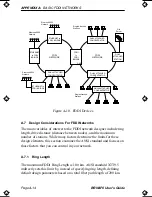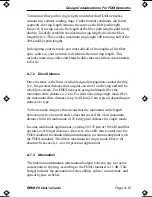
Design Considerations For FDDI Networks
BRIM-F6 User’s Guide
Page A-15
To translate fiber path to ring length, remember that FDDI networks
contain two counter-rotating rings. Under normal conditions (no failed
segment), the ring length remains the same as the fiber path length.
However, if a wrap occurs, the length of the fiber path length could nearly
double. To safely establish the maximum ring length, divide the fiber
length by two. This yields a maximum ring length 100 km (one-half of the
200 km fiber path length).
In designing your network, you must add all of the lengths of the fiber
optic cables in your network to determine the total ring length. This
includes main ring cables and branch cables that reach from concentrators
to SASs.
A.7.2
Drive Distance
Drive distance is the limit of reliable signal propagation around the ring.
(i.e., the greatest distance that a signal can travel on the ring and still be
reliably received). For FDDI networks using multimode fiber the
maximum drive distance is 2 km. For networks using single mode fiber,
the maximum drive distance is up to 40 km (25 km typical) depending on
transceiver type.
To the network designer, this means that the maximum cable length
between any two network nodes must not exceed the 2 km maximum
distance limit for multimode or 25 km typical distance for single mode.
In some multimode applications, existing 50/125
µ
m or 100/140
µ
m fiber
operates over longer distances. However, the cable must conform to the
FDDI standard for bandwidth and attenuation to remain compliant with
the FDDI standard. The 40 km maximum for single mode fiber is for
absolute best-case (i.e., not for practical application).
A.7.3
Attenuation
The maximum attenuation (attenuation budget) between any two active
connections to the ring, according to the FDDI standard, is 11 dB. This
budget includes the attenuation of the cabling, splices, connections, and
optical bypass switches.
BRIM-F Book Page 15 Monday, January 29, 1996 9:26 AM



































